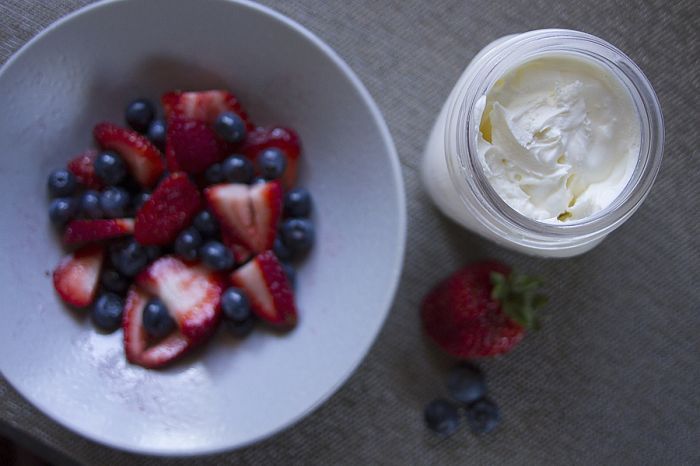Cultured Swirls

By Christine Hyatt
There is something so intriguing about French words that have made a home for themselves in the English lexicon, and deliciously decadent crème fraîche is no exception.
This alluring French creation, useful in practically any dish, may be increasingly common on menus, but it is still not as well-known state side as its Anglicized cousin, sour cream. But crème fraîche is rapidly gaining popularity with the help of top chefs and producers like Bellwether Farms.
Traditional crème fraîche contains only cream and a bacterial culture. Sitting at room temperature for 12 to 24 hours, the bacteria multiply and sour the cream, producing a thick, unctuous and slightly sour concoction that can be dolloped on whatever you’re cooking.
Crème fraîche is perfect as a topping for fresh berries, and, because it does not curdle; it is also used to thicken all manner of soups and sauces. The cream is such a French staple that Julia Child included a recipe for it in all her cookbooks.
Although even adventurous home chefs may shy away from making their own dairy products, crème fraîche is exceedingly simple. The combination of fresh cream and a culture (either a crème fraîche culture or cultured buttermilk, which may be found more easily) can result in a truly decadent, homemade treat (see recipe to the left). Of course, since the ingredients are so few, it is important to remember that the higher the quality of the cream, the better the final product.
Those who may not want to undertake homemade crème fraîche can take comfort in the fact that it is much more widely available commercially, than it once was in American markets. In addition, many commercial versions are just as good, if not better, than the homemade equivalent due, in part, to the quality of milk available to commercial producers who seek it out.
The increased availability of crème fraîche in the U.S. is certainly due at least in part to the efforts of Bellwether Farms in Petaluma, Calif.
Bellwether Farms was founded by Cindy Callahan in 1986. She left her first career as a nurse and plunged into an entirely different field, raising sheep and crops on her farm in Northern California. The sheep were originally brought in as pastoral lawnmowers, adding a bucolic touch while controlling grass on the farm. It was not until a neighbor suggested Callahan start milking the sheep that cheesemaking became a viable option. But that slight encouragement was all she needed.
Callahan and her son, Liam, began making cheese in 1990. As part of the first wave of the new American artisan tradition, Bellwether sheep’s milk cheeses, like Carmody and Pepato, were regional successes in the Bay Area. Soon, cow’s milk cheeses were added to the lineup, as well. It was the cream from the Bellwether Jersey cow’s milk that Liam turned into the first Bellwether crème fraîche. It was no shrewd marketing ploy; rather the result of a customer request.
As an experiment, he scooped some cream from a container of fresh whole milk and gave it the inquiring customer; and Bellwether Crème Fraîche was born.
Today, Bellwether Farms’ crème fraîche is among the most delicious and widely available brands on the market. It can be found in local dairy cases across the country and consistently lives up to the cheesemaker’s high standards for their products.
Whether you DIY or leave the culturing to the pros, crème fraîche is a gourmet pleasure sure to become an American kitchen staple.












